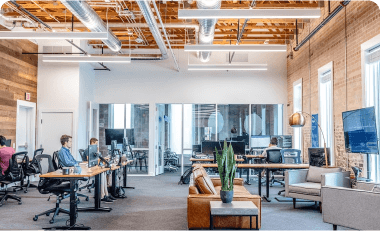
The hybrid workplace is not new but quickly becoming the norm. The majority of employees want to return to work for most of the week after the epidemic, but they also want the option to work remotely.
There are few contrasts between remote employees and employees who operate under the same roof in a genuinely linked workplace. If this seems like a workplace utopia, be assured that it exists—and that developing technologies are moving us closer to it every day.
What is a Hybrid Workplace?
Employees in a hybrid workplace split their time between working in the offices and working remotely. However, simply having this paradigm in place does not ensure success. A successful hybrid work environment accommodates various working styles and schedules, helping employees have a stable system and be productive regardless of where they are. For example, an employee may work from home on Monday and participate in a virtual meeting with colleagues. When she returns to the office on Tuesday morning for a follow-up, she should be able to immediately pick a room to reconnect with them, readily access all the papers they exchanged the day before, and video calls another remote team member to join the discussion. She should be allowed to pick which days she works in the office and from home.
The Benefits of a Hybrid Approach
While the hybrid approach has surely challenged firms to rethink how they function, it has resulted in various useful and unique advancements.
To begin with, in the context of the epidemic, the ability to transition to partially or totally digital employment has been a lifeline – physically for people and symbolically for enterprises. Given the demand for social separation and safety as the number one concern in a health crisis, the hybrid model has shown to be a feasible choice for employment.
Aside from the immediate safety function of this transition, the hybrid approach is transforming how businesses view their operations. Instead of relying on physical attendance at the workplace, more and more businesses are focused on outcomes and productivity. Employees are held accountable for performing actual work rather than showing up at their desks for eight hours daily.

Guide to Creating a Hybrid Workplace
Determine the needs of employees for hybrid work. People have become accustomed to the freedom to choose where and when they work to accommodate their job load, parenting, and other family obligations. Before developing a hybrid model suited for your organisation, talk to your staff to understand their needs. You may establish a workable model that prepares individuals for change and inspires them to do their best job by including your team. Surveys are the most effective technique to measure employee attitudes toward mixed employment.
Improve the workplace experience. Building relationships is critical to your success and the creation of a healthy work environment. It's also critical to regularly ask for feedback about their remote working. You'll discover what works effectively and what may be changed in order to establish a people-centered workplace. Focusing on creating connections, ensuring employees are satisfied with their workplace, and keeping it orderly will have a long-term impact. Finally, remember to be patient with yourself and others. Build relationships incrementally through planning and execution, allowing for creating and implementing a better workplace.
Build and test the infrastructure for adaptability. When done well, hybrid work will integrate remote and on-site locations, making it simple for employees to collaborate. Investing in workplace technology, such as remote communication methods and on-site video conferencing equipment, will assist in this endeavour. Determine if you require new tools or whether you can repurpose current ones.
Create office calendars to control workplace traffic and provide employees freedom. There are several solutions to this problem. For example, your hybrid work model may feature a hybrid discretionary policy that allows workers to pick which days they come to work. You may also use a hybrid manager scheduling technique, which allows managers to control schedules and determine which days their staff come into the office.
Enhance the employee experience. An office makeover is required first to improve the employee experience in a hybrid work style. Employee productivity may be maintained remotely when employees' usage of office space becomes more meaningful and awareness of the need for cooperation and creative environments has grown. Furthermore, corporations have worked hard to replicate the social component of office life, which is crucial to establishing and creating corporate culture. That is why you must ensure that your staff has adequate space.
Second, it is critical to control space using a reservation system. The flexibility for employees to access the areas they require, dependent on the activity at hand, is at the heart of a hybrid work environment. Reservation systems help with this by allowing people and groups to select when it is best to visit the workplace and which area is ideal for them. Online bookings are quick and straightforward, whether they are made a week in advance or at the last minute, at home, at the workplace, or while travelling.
Concentrate on personnel well-being and safety. When firms begin to re-open workplaces, priority number one is ensuring that social distancing and occupancy regulations are observed and explicitly conveyed to employees. The workplace must have a regulated environment in which the HR and facilities teams can respond swiftly to any changes. Teams must prepare ahead of time how they will limit occupancy levels and ensure employees that the workplace is safe to return to.
What is Hybee and Why Should You Choose It?
Hybee offers data-driven solutions for creating an effective hybrid workspace for your staff. Users may organize their workplace days using this program by making table and meeting room bookings and entering data such as transportation to the office, dining hall, and parking lot usage into the system. The solution saves time, helps you maximize your resources, and improves the employee experience by evaluating this data.
Your employees may schedule their workplace days whenever and wherever they choose using Hybee. It enhances the employee experience by supporting the hybrid working system and allowing users to access office usage data such as cafeteria, service, parking lot, table, and meeting room via the system. Hybee provides data-driven solutions to improve workspace productivity and staff enthusiasm. Hybee, with all of its functionalities, assists you in creating dynamic and adaptable workplaces that are appropriate for today's work culture.













